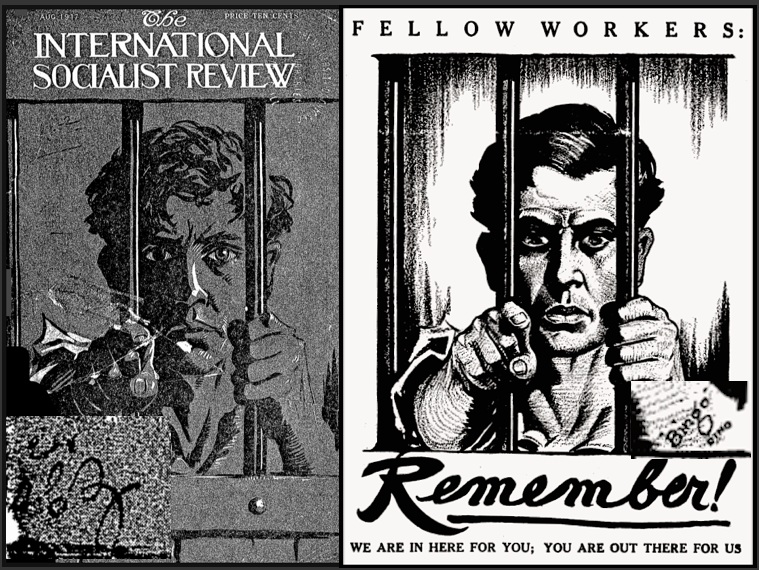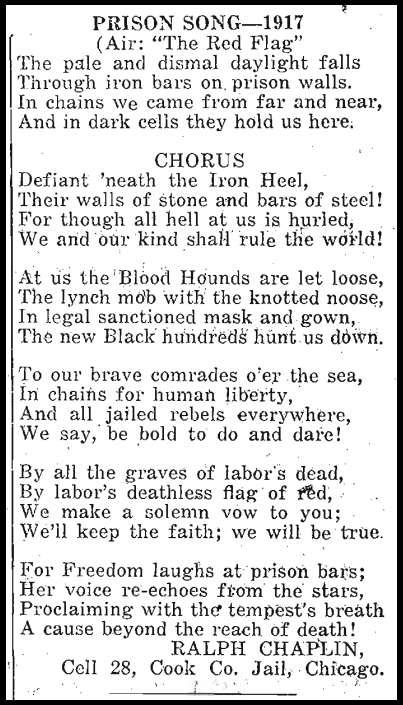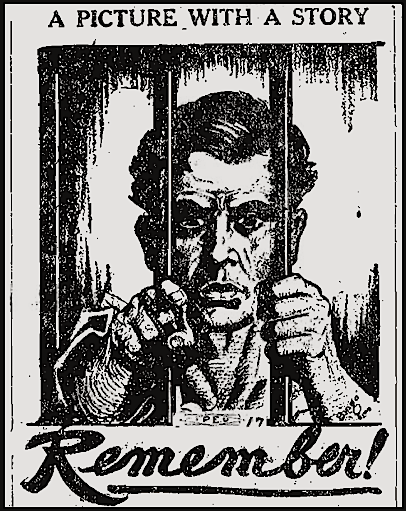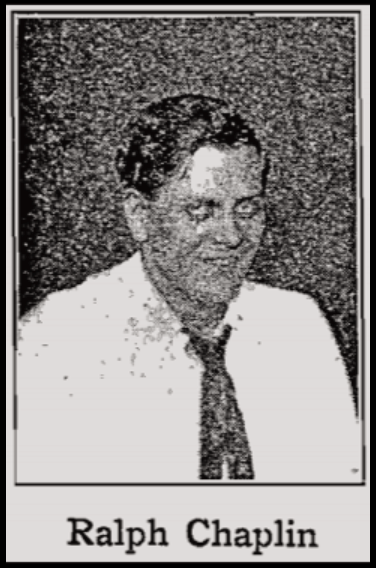For Freedom laughs at prison bars;
Her voice re-echoes from the stars,
Proclaiming with the tempest’s breath
A cause beyond the reach of death!
-Ralph Chaplin
Hellraisers Journal, Tuesday March 12, 1918
From the Cook County Jail: “Prison Song” by Ralph Chaplin
From The Ohio Socialist of March 10, 1918:
———-
———-
March 5, 1918.
The Ohio Socialist,
Comrades: Perhaps the enclosed story of the Picture with a Story is not too long to be available. If it is, cut it down.
Am enclosing on the reverse side of this a little I. W. W. prison song. May be you will care to use it at some future date.
May say that the educational features of the Ohio Socialist were heartily enjoyed by the bunch in jail here. Hope you’ll keep us on the list.
Would have written sooner, but was waiting for an argument in court that might have meant good news.
With best wishes.
“Yours for ours,”
R. H. C.———-
How It Came To Be
By one of the 166 I. W. W.’s,
Cook County Jail, Chicago
“Birds of Freedom are always jailbirds” is an axiom the truthfulness of which is daily becoming more evident. Men and women of the great present day army of Industrial Emancipation are prouder of their jail experiences than were the soldiers of any war of the wounds of battle. Hand-cuffs are no longer a part of the insignia of infamy; gained honorably in the holy fight against the oligarchs of capitalism and worn by the dauntless high headed political prisoners of today, they have become a mark of high honor exceeding that which any world-power can possibly bestow.
And the “Picture With a Story” was inspired by, and is eloquent of this new spirit of working class rebellion against the loathsome capitalist system.
The story of this picture is one of real interest and genuine romance. It was drawn by a construction worker in far off Australia at the time Tom Barker and eleven other members of the I. W. W. were given long sentences on trumped-up charges. This was over a year ago. Real news of the revolutionary labor movement in the antipodes has long since been cut off by the war time censor, but there is no doubt the picture has had lots of work to do since that time.
I. W. W. papers for about two years have not been permitted to cross the Pacific ocean either way. But the sun never sets on the One Big Union, and a sailor’s boot is sometimes as good as a mail bag. At all events, a thumb-worn, sea-stained and tattered copy of the Australian I. W. W. organ, “Direct Action,” containing the picture reached the office of “Solidarity” in Chicago. This was just before the now historic governmental raids and arrests of I. W. W. officials and members.
Realizing full well that wholesale incarceration was impending for many active rebels, Solidarity’s cartoonist, “Bingo,” immediately set about to re-draw the picture in order to have the cuts ready for instant use. “Bingo” just finished the drawing in time. He was working on a pen and ink sketch of the same design to be used for an I. W. W. defense stamp when the “Visitors” for the Department came to arrest him.
Since then millions of copies of “the picture with a story” have been printed by the I. W. W. alone. On leaflets, buttons banners, stickers and countless papers the Man Behind the Bars tells his eloquent message to the workers of the world, and the end is not yet!
The One Big Union has taken in over 25,000 new members since the arrests of last September.
Cheer up, comrades, the more they persecute us the faster they dig their own graves.
[Photograph of Ralph Chaplin added.]
———-
SOURCE & IMAGES
The Ohio Socialist
“Official Organ of the Socialist Party of Ohio”
(Cleveland, Ohio)
-Mar 10, 1918
Page 2: “Prisoners’ Page”
https://www.marxists.org/history/usa/pubs/ohio-socialist/016-mar-10-1918.pdf
IMAGES
Ralph Chaplin, ISR p324, Jan 1918
https://archive.org/stream/ISR-volume18#page/n166/mode/1up
See also:
“In Here for You”/”Man Behind the Bars”

In Here for You, by Unknown, ISR of Aug 1917
-& by Ralph Chaplin, Solidarity of Aug/Sept 1917
Hellraisers Journal, Friday August 24, 1917
Tag: Bingo
https://weneverforget.org/tag/bingo/
Tag: Ralph Chaplin
https://weneverforget.org/tag/ralph-chaplin/
Ralph Chaplin in Cook County Jail
Wobbly
The Rough-and-Tumble Story of an American Radical
-by Ralph chaplin
Chicago, 1948
https://books.google.com/books/about/Wobbly.html?id=n-ygPQAACAAJ
About the time of this article in the Ohio Socialist, I believe, Ralph Chaplin was released on bail from the Cook County Jail. According to his account, he was released shortly after the release of Big Bill Haywood who was released on February 12th. Unfortunately the papers did not cover Chaplin’s release as they did Haywood’s:
Hellraisers Journal, Thursday February 21, 1918
Big Bill Haywood Now Out on Bail from Cook County Jail
IWW Leader Big Bill Haywood Released from Cook County Jail on Bail of $15,000
On page 237-238 of Wobbly, Chaplin wrote:
Bill Haywood was released on bail just before the trial started, I shortly afterward. The authorities vigorously opposed our release. Bill’s bail, officially set at $30,000 required over three times that amount before arbitrary requirements were met. Edith [Chaplin’s wife] had the identical experience in raising bail for me. In Bill’s case, William Bross Lloyd, of Chicago, put up cash real estate, and Liberty Bonds; Mary and Leslie Marcy put up their bungalow. In my case William Bross Lloyd and good old John F. Higgins put up over $100,000 in real estate, while Rao, Essie, and my old friend Jacob Bruning furnished the rest, in real estate and Liberty Bonds. That evening as we left the courtroom for our now too familiar cells, red-and white lights in front of the Federal Building were still flashing alternately “The Red Viper” and “The Menace of the I.W.W.” Vanderveer [IWW attorney] had informed me that my bonds had been approved and that I would be released on bail the following morning. It was long night…
On pages 236-237, Chaplin describes his worst experience behind the bars of the Cook County Jail:
I had heard about the “Island.” More than once I had seen prisoners return from it, with trembling hands and white, drawn faces. They spoke of their experiences in awed whispers. One day on my way to the visitor’s cage with “Pinky” the runner, I asked him about it. Looking upward into the horrible vastness of the new jail, he pointed to the topmost tier of cells. “There it is,” he explained, “and it’s hell in high places. No lights up there, and it’s plenty cold.” The lofty ceiling was veiled with a dirty mist. There were six galleries to each of the cell blocks, and the “Island” was at the very top, well above the tallest barred window and on the dark side. “Stay clear of that place,” cautioned “Pinky.” “It’s only one step from there to the ‘nut ward.'” But I didn’t succeed in staying clear of the “Island.” Several of the I.W.W. boys made the trip after a Thanksgiving Day protest against the jailhouse menu, and I was one of them. The society section of the Can Opener carried a brief notice to the effect that we were spending the holidays “on the Island.”
It was a bare steel cell without light, bunk, or blanket. During the daytime there was a continuous hivelike murmur of many voices from far below, but at night the silence was appalling. There was a spindly board hammock in the cell. Twice a day two pieces of bread were placed between the bars by a felt-shod “screw.” As I had no taste for such diet, the bread collected on the cell door. The truth is that it was so cold that the chattering of my teeth made eating impossible. After the first few days my hunger was replaced with a feeling of exhilaration. Edith and Vonnie [Chaplin’s son] were closer to me than ever before. I relived all the happy hours I had spent with them, and Brighton Park, Panora, Dodge City, Mexico, and Montreal came back and hundreds of incidents these memories evoked.
The day before I was released from solitary confinement I had a strange experience. The dark cell was suffused with white light and seemed to expand until it was a vast as the universe. For one brief second everything I had ever wondered about became clear. All the parts of the jigsaw puzzle fitted together perfectly. I looked Life squarely in the face, and it was a challenge that I felt unable to accept. It was not Humanity being crucified; it was Humanity crucifying itself. And I was part of it, as willful as the rest and as out of step with universal law as the rest. I remember coming out of it with the cry,”O God!” wrenched from my shivering insides. At that moment I doubted whether I had the strength to go on.
There was a new guard on duty that night. I heard him stop in front of my cell. Looking at the accumulated crusts on the barred door, he shook his head sadly. “For God’s sake, what are they doing to you?” he asked. When I told him I was all right, he said, “I’d give anything in the world if I could help you.” It was worth a stretch in isolation just to learn what a kind work can mean.



